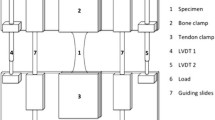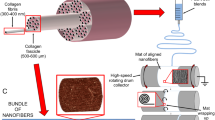Abstract
Accurate determination of the biomedical properties of connective tissue such as tendons and ligaments is dependent on the accurate measurement of their cross-sectional area (CSA). To date, techniques for determining cross-sectional areas of ligaments and tendons have been less than ideal due to their complex geometries and their deformations under external load. A novel non-destructive technique has been developed for determining the cross-sectional area of tendon by locating the tendon rupture, in which aqueous rapid curing alginate dental molding materials, digital photography and computerized image analysis are utilized. This technique marks tendons and alginate molds at 1 cm interval and then tendons are taken out for tensile test. Real-time video is recorded to locate the position of tendon rupture. The corresponding alginate slice is found and then analysis through computer image processing software to obtain a more accurate CSA at tendon rupture, which can be used to calculate the stress and young’s modulus of tendon. The accuracy of this technique has been investigated and comparisons have been made with the alginate un-localization molding technique and ellipse estimation technique. Results show this technique can provide accurate CSA values (within 2%) and great reproducibility (coefficient of variation = 0.8%). The technique is non-destructive, can obtain morphological information of soft tissue and can detect cavities.








Similar content being viewed by others
Abbreviations
- CSA:
-
Cross-sectional area
- CV:
-
Coefficient of variation
- ICC:
-
Intraclass correlation coefficient
References
Abrahams M (1967) Mechanical behaviour of tendon in vitro: a preliminary report. Med Biol Eng 5(5):433–443. https://doi.org/10.1007/BF02479137
Anderson AF, Dome DC, Gautam S, Awh MH, Rennirt GW (2001) Correlation of anthropometric measurements, strength, anterior cruciate ligament size, and intercondylar notch characteristics to sex differences in anterior cruciate ligament tear rates. Am J Sports Med 29(1):58–66. https://doi.org/10.1177/03635465010290011501
Bartlett JW, Frost C (2008) Reliability, repeatability and reproducibility: analysis of measurement errors in continuous variables. Ultrasound Obstet Gynecol 31(4):466–475. https://doi.org/10.1002/uog.5256
Cronkite AE (1936) The tensile strength of human tendons. Anat Rec 64(2):173–186. https://doi.org/10.1002/ar.1090640205
Ellis DG (1969) Cross-sectional area measurements for tendon specimens: a comparison of several methods. J Biomech 2(2):175–186. https://doi.org/10.1016/0021-9290(69)90029-3
Goodship AE, Birch HL (2005) Cross sectional area measurement of tendon and ligament in vitro: a simple, rapid, non-destructive technique. J Biomech 38(3):605–608. https://doi.org/10.1016/j.jbiomech.2004.05.003
Haut RC, Little RW (1969) Rheological properties of canine anterior cruciate ligaments. J Biomech 2(3):289–298. https://doi.org/10.1016/0021-9290(69)90085-2
Hayes A, Easton K, Devanaboyina PT, Wu J-P, Kirk TB, Lloyd D (2016) Structured white light scanning of rabbit Achilles tendon. J Biomech 49(15):3753–3758. https://doi.org/10.1016/j.jbiomech.2016.09.042
Lanzendorf DJ, Murphy MC, Mann RW (1988) Measurements of ligament tissue cross-sectional area. In: Proceedings of the 1988 fourteenth annual northeast bioengineering conference, pp 22–25. https://doi.org/10.1109/NEBC.1988.19333
Lee TQ, Woo SL-Y (1988) A new method for determining cross-sectional shape and area of soft tissues. J Biomech Eng 110(2):110. https://doi.org/10.1115/1.3108414
Marcus JE (1954) Repeatability and reproducibility. Cancer Cell 26(6):771–772. https://doi.org/10.1016/j.ccell.2014.11.023
Masahiko N, ToshiyaKusaka K, Kazuya I, Yoshiaki K (2002) A method of in vitro measurement of the cross-sectional area of soft tissues, using ultrasonography. J Orthop Sci 7(2):247–251. https://doi.org/10.1007/s007760200041
Matthews LS, Ellis D (1968) Viscoelastic properties of cat tendon: effects of time after death and preservation by freezing. J Biomech 1(2):65–71. https://doi.org/10.1016/0021-9290(68)90008-0
Moon DK, Abramowitch SD, Woo SL-Y (2006) The development and validation of a charge-coupled device laser reflectance system to measure the complex cross-sectional shape and area of soft tissues. J Biomech 39(16):3071–3075. https://doi.org/10.1016/j.jbiomech.2005.10.029
Nunley RL (1958) The ligamenta flava of the dog. A study of tensile and physical properties. Am J Phys Med 37:256–268
Pokhai GG, Oliver ML, Gordon KD (2009) A new laser reflectance system capable of measuring changing cross-sectional area of soft tissues during tensile testing. J Biomech Eng 131(9):094504. https://doi.org/10.1115/1.3194753
Race A, Amis AA (1996) Cross-sectional area measurement of soft tissue. A new casting method. J Biomech 29(9):1207–1212. https://doi.org/10.1016/0021-9290(96)00022-x
Rigby BJ, Hirai N, Spikes JD (1959) The mechanical properties of rat tail tendon. J Gen Physiol 43:265–283
Schmidt KH, Ledoux WR (2010) Quantifying ligament cross-sectional area via molding and casting. J Biomech Eng 132(9):091012. https://doi.org/10.1115/1.4001881
Shrout PE (1998) Measurement reliability and agreement in psychiatry. Stat Methods Med Res 7(3):301–317. https://doi.org/10.1191/096228098672090967
Shrout Patrick E, Fleiss JL (1979) Intraclass correlations: uses in assessing rater reliability. Psychol Bull 86(2):420–428. https://doi.org/10.1037/0033-2909.86.2.420
VanBrocklin J, Ellis DG (1965) A study of the mechanical behavior of toe extensor tendons under applied stress. Arch Phys Med Rehabil 46:369–373
Vergari C, Pourcelot P, Holden L, Ravary-Plumioën B, Laugier P, Mitton D, Crevier-Denoix N (2010) A linear laser scanner to measure cross-sectional shape and area of biological specimens during mechanical testing. J Biomech Eng 132(10):105001. https://doi.org/10.1115/1.4002374
Walker LB, Harris EH, Benedict JV (1964) Stress-strain relationship in human cadaveric plantaris tendon: a preliminary study. Med Electron Biol Eng 2(1):31–38. https://doi.org/10.1007/BF02474358
Woo Savio L-Y, Danto MI, Ohland KJ, Lee TQ, Newton PO (1990) The use of a laser micrometer system to determine the cross-sectional shape and area of ligaments: a comparative study with two existing methods. J Biomech Eng 112(4):426. https://doi.org/10.1115/1.2891206
Wren TAL, Yerby SA, Beaupré GS, Carter DR (2001) Mechanical properties of the human achilles tendon. Clin Biomech 16(3):245–251. https://doi.org/10.1016/S0268-0033(00)00089-9
Zhang T, Long W, Sato Y (2003) Availability of systems with self-diagnostic components—applying Markov model to IEC 61508-6. Reliab Eng Syst Saf 80(2):133–141. https://doi.org/10.1016/S0951-8320(03)00004-8
Acknowledgements
This work was performed at Beijing Wonderful Medical Biomaterial Co. Ltd.
Funding
This study was funded by National key R&D program of China (Grant No. 2018YFC1106700).
Author information
Authors and Affiliations
Corresponding author
Ethics declarations
Conflict of interest
Author Bin Liu has received research grants from National key R&D program of China. Author Xiaojing Ge was applying a Chinese patent for invention named A Novel Alginate Localization Molding Technique and Device for Cross-Sectional Area Measurement. The authors declares that they have no conflict of interest.
Ethical approval
This study used human tendon from one cadaver. Ethics committee approval letter is attached. All procedures performed in studies involving human participants were in accordance with the ethical standards of the institutional and/or national research committee and with the 1964 Helsinki declaration and its later amendments or comparable ethical standards.
Additional information
Publisher's Note
Springer Nature remains neutral with regard to jurisdictional claims in published maps and institutional affiliations.
Jinju Ding is Co-first author.
Rights and permissions
About this article
Cite this article
Ge, X., Ding, J., Wang, M. et al. A novel alginate localization molding technique for cross-sectional area measurement of human tendon to access biomechanical properties. Cell Tissue Bank 22, 11–24 (2021). https://doi.org/10.1007/s10561-020-09858-9
Received:
Accepted:
Published:
Issue Date:
DOI: https://doi.org/10.1007/s10561-020-09858-9




